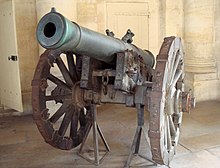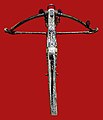Musée de l'Armée

|
|
| Data | |
|---|---|
| place | Hôtel national des Invalides, 129 rue de Grenelle, 75007 Paris |
| Art | |
| architect | Libéral Bruant |
| opening | 1905 |
| Number of visitors (annually) | 1.3 million (2013) |
| operator | |
| management | |
| Website | |
The Musée de l'Armée ( German Army Museum ) is the central museum for military history in France and one of the most important in the world. It was founded in 1905 in the Hôtel des Invalides building complex in the 7th arrondissement of Paris by merging the Artillery Museum with the Historical Army Museum.
history
The original military history museums were
- the artillery museum ( Musée d'Artillerie ) founded in 1795
- and the Historical Army Museum ( Musée Historique de l'Armée ) founded in 1897 .
In the course of the French Revolution (1789), the artillery museum was first built. The holdings were expanded under the reign of Napoleon Bonaparte . In 1871, it moved to the Hôtel des Invalides building complex, now a listed building, on Rue de Grenelle in the 7th arrondissement of Paris. This was built in the 17th century at the instigation of the French King Louis XIV by the architect Libéral Bruant. Following the Paris World Exhibition in 1889 , another military museum, the Historical Army Museum, was launched. Both institutions merged in 1905 to form the Army Museum.
Stock and premises
The military historical inventory includes over 500,000 objects from the Middle Ages to the modern age , u. a. Photos , paintings , medals , armor , sculptures , uniforms , weapons . The museum offers an exhibition area of approx. 8000 m². A "historical collection", which also includes the time of the Second World War , functions as a permanent exhibition . Various "thematic collections" are shown in the temporary exhibitions . The following exhibition buildings and rooms belong to the Army Museum:
- The Invalides with the tomb of Emperor Napoleon I and the soldiers' church ,
- the classic French cannons in the main courtyard,
- the old equipment and weapons (from the 13th to 17th centuries),
- the exhibition area Ludwig XIV. to Napoleon III. (from 1643 to 1870),
- the exhibition area of the two world wars (from 1871 to 1990)
- and the Historial Charles de Gaulle .
Invalides and Soldiers Church
French cannons
In the courtyard French than 200 years have more artillery history on display. The visitor can see the beginnings of the Keller brothers and the classic French cannons . From the middle of the 17th century, the Gribeauval and later Valées models replaced the original field artillery . You can also see mortars and howitzers that were made during the coalition wars.
Ancient armor and weapons
One of the world's largest weapon collections is located in the local exhibition area. Before the tour, the “Crown Collections” (Louis XIV) are presented in the royal hall . This is followed by the medieval hall , which is filled with various weapons of war , beginning in the feudal era. The Ludwig XIII room outlines with its exhibits the French wars in the 16th and 17th centuries and in a separate cabinet Ottoman collections of the same kind. In addition to the themed gallery of the arsenal and the " knightly ways of life", including hunting and tournaments , the visitor comes across various thematic collections ( Oriental cabinets , large rifle cabinets and Europa room ). The latter cabinet includes Germany and Italy.
From the Ancien Régime to the Second Empire
Chronologically, the time from Louis XIV to Napoleon III. processed. Initially the Ancien Régime , which was eliminated by the French Revolution. As a result, Napoleon Bonaparte waged his coalition wars and subjugated large parts of Europe at the beginning of the 19th century. He is eventually defeated in the Battle of Waterloo . After the restoration , developments in Central Europe lead to the Franco-German War , the result of which ended the Second Empire . The museum guest is introduced to the topics described through historical exhibits such as paintings, medals and musical instruments.
The two world wars
This area of the exhibition brings the two great world wars of the 20th century closer. Several rooms with numerous objects serve this purpose: Room Alsace-Lorraine (from 1871: restructuring after the defeat in the Franco-German War ), Room Joffre (1914: Colonial power France and assassination of Sarajevo ), Room Poilus (1915–1917: First World War in Overview), Room Foch (1918: German spring offensive and armistice of Compiègne ), Room Leclerc (1939–1942: Western campaign , Vichy regime and formation of the Forces françaises libres ), Room Juin (1942–1944: Resistance ) and Room Lattre (1944 / 45: Operation Neptune (D-Day) and the end of the Second World War in the form of the unconditional surrender of the Wehrmacht )
Historial Charles-de-Gaulle
The Historial Charles-de-Gaulle is an audiovisual room with more than 400 documents, including a. Photos, maps and posters . Starting with a biographical film about the general and statesman Charles de Gaulle, resistance fighter, founder of the Fifth Republic and President from 1959 to 1969, the “course of the century” introduces important personalities of the 20th century. The permanent exhibition that follows shows de Gaulle's most important stations.
Exhibitions
- 2017: France - Allemagne (s) - La guerre, la commune, les mémoires . Catalog.
Exhibits
literature
- Gilles Aubagnac (Red.): Invalides, Musée de l'Armée. 1939–1945, la Deuxième guerre mondiale. Collections historiques . Perrin, Paris 2001, ISBN 2-262-01836-7 .
- Jean Humbert: The Museum of the Army (= The Invalides . Volume 2). Editions de la Tourelle, Paris 1978. (French original title: Le Musée de l'Armée et souvenirs Napoléoniens)
- Laurent Mirouze, Stéphane Dekerle: The French Army in the First World War. Uniforms - Equipment - Armament . 2 volumes, Verlag Militaria , Vienna 2007/2008. (Images come from the Musée de l'Armée in Paris and Salon-de-Provence)
- Volume 1: March 1914 . Translation from French by Klaus-Jürgen Bremm , 2007, ISBN 978-3-902526-08-3 .
- Volume 2: 1914 to 1918 . Translation from French by Elmar Heinz, 2008, ISBN 978-3-902526-19-9 .
- Thomas Thiemeyer: Continuation of the war by other means. The two world wars in the museum (= war in history . Volume 62). Schöningh, Paderborn u. a. 2010, ISBN 978-3-506-76919-0 , p. 56 ff.
Web links
- Literature from and about the Musée de l'Armée in the catalog of the German National Library
- Website of the Musée de l'Armée (also in German)
Individual evidence
Coordinates: 48 ° 51 ′ 20.9 " N , 2 ° 18 ′ 45.5" E













